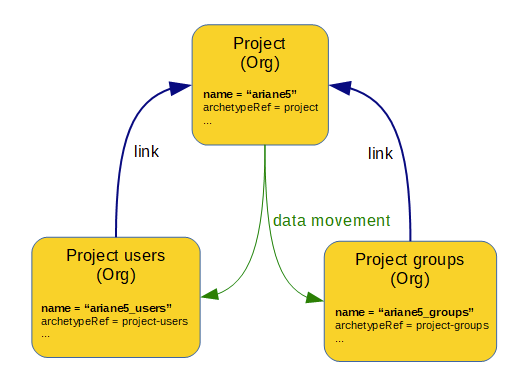
Linked Objects Scenario 3: Projects
|
This scenario uses unfinished/experimental named object links feature. It is very powerful but even more experimental than linked objects feature as a whole! So beware, everything described here can change any time. |
Overview
Let us work with projects modeled as OrgType objects of archetype project. Each project named P has two child orgs.
The first (named <P>_users, having archetype of project-users) contains users working on that particular project.
The second (named <P>_groups, having archetype of project-groups) contains groups that are related to that project.
-
When a project is created, those children have to be created automatically.
-
When a project is renamed, those two children should be renamed automatically.
-
When a project is deleted, those children have to be deleted automatically.

An implementation overview
As usual, the implementation has two parts:
-
Implementing the data transfers as such. There are two simple mappings (that set sub-orgs
nameattribute) that ensure this. -
Triggering the recomputation of linked objects. There are three policy rules doing that.
Data transfer implementation using mappings
This is how project-users archetype looks like:
<archetype xmlns="http://midpoint.evolveum.com/xml/ns/public/common/common-3"
oid="3af67ba4-183f-45e7-887e-4ae5ddff4cdf">
<name>project-users</name>
<documentation>
"Users" sub-org for project org.
</documentation>
<archetypePolicy>
<links>
<targetLink>
<name>parent</name>
<selector>
<type>OrgType</type>
<archetypeRef oid="4d3280a1-6514-4984-ac2c-7e56c05af258" /> <!-- project -->
</selector>
</targetLink>
</links>
</archetypePolicy>
<inducement>
<focusMappings>
<mapping>
<strength>strong</strength>
<expression>
<script>
<code>
parent = midpoint.findLinkedTarget('parent')
parent ? parent.name + '_users' : null
</code>
</script>
</expression>
<target>
<path>name</path>
</target>
</mapping>
</focusMappings>
</inducement>
</archetype>First of all, a link type of parent is defined.
It denotes the parent org of any "users" sub-org.
The mapping that follows derives sub-org name from the name of the parent by suffixing it by "_users" text. Nothing special here.
The archetype of project-groups looks exactly the same.
inked user (if any).
And the mapping returns the value for the description property accordingly.
Change propagation
All what is needed to propagate changes (creation/modification/deletion of parent org) is present in project archetype.
It starts like this:
<archetype xmlns="http://midpoint.evolveum.com/xml/ns/public/common/common-3"
xmlns:s="http://midpoint.evolveum.com/xml/ns/public/model/scripting-3"
oid="4d3280a1-6514-4984-ac2c-7e56c05af258">
<name>project</name>
<documentation>
A project has two child objects: users and groups.
1. These are to be created when project is created.
2. They need to be deleted when project is deleted.
3. They need to be renamed when project is renamed.
</documentation>
<archetypePolicy>
<links>
<sourceLink>
<name>usersOrg</name>
<selector>
<type>OrgType</type>
<archetypeRef oid="3af67ba4-183f-45e7-887e-4ae5ddff4cdf" /> <!-- project-users -->
</selector>
</sourceLink>
<sourceLink>
<name>groupsOrg</name>
<selector>
<type>OrgType</type>
<archetypeRef oid="a85bddc9-4ff0-475f-8ccc-17f9038d4ce1"/> <!-- project-groups -->
</selector>
</sourceLink>
</links>
</archetypePolicy>
...
</archetype>We see a definition of two link types here.
One is called usersOrg and points to the OrgType of project-users archetype that has the project as its parent (assignment target).
The other one is called groupsOrg and points to the OrgType of project-groups archetype that - again - has the project as its parent.
Project creation
Further there is a policy rule that creates children when project org is created:
<archetype xmlns="http://midpoint.evolveum.com/xml/ns/public/common/common-3"
xmlns:s="http://midpoint.evolveum.com/xml/ns/public/model/scripting-3"
oid="4d3280a1-6514-4984-ac2c-7e56c05af258">
...
<inducement>
<policyRule>
<name>create-children-on-new-project-creation</name>
<documentation>
Creates children when new project is created.
</documentation>
<policyConstraints>
<modification>
<operation>add</operation>
</modification>
</policyConstraints>
<policyActions>
<scriptExecution>
<!-- no object spec, so executed on the object itself -->
<executeScript>
<s:pipeline>
<s:execute>
<s:script>
<code>
// Returning two objects - they will be created in the second action
[midpoint.createLinkedSource('usersOrg'),
midpoint.createLinkedSource('groupsOrg')]
</code>
</s:script>
<s:outputTypeName>OrgType</s:outputTypeName>
</s:execute>
<s:add/> <!-- creates objects prepared above -->
</s:pipeline>
</executeScript>
</scriptExecution>
</policyActions>
</policyRule>
</inducement>
...
</archetype>It is executed against the project org itself - no linkSource/linkTarget specification is there.
And it is a two-step pipeline:
-
The first step uses
midpoint.createLinkedSourcemethod (of PoC quality only, rather unfinished) to create objects from the respective link type specifications. Those objects are very simple, each one contains only a reference to its parent (the project) and its archetype (derived from the link type). Everything else is computed from the archetype itself in the second step. -
And the second step i.e.
s:addaction creates the objects.
Project deletion
What about deletion?
<archetype xmlns="http://midpoint.evolveum.com/xml/ns/public/common/common-3"
xmlns:s="http://midpoint.evolveum.com/xml/ns/public/model/scripting-3"
oid="4d3280a1-6514-4984-ac2c-7e56c05af258">
...
<!--
Actually, this one is fake: assignments/inducements are NOT evaluated on object deletion (yet).
So the same rule is included as a global policy rule in system configuration.
-->
<inducement>
<policyRule>
<name>delete-children-on-project-deletion</name>
<documentation>
Deletes children when project is deleted.
</documentation>
<policyConstraints>
<modification>
<operation>delete</operation>
</modification>
</policyConstraints>
<policyActions>
<scriptExecution>
<object>
<namedLinkSource>usersOrg</namedLinkSource>
<namedLinkSource>groupsOrg</namedLinkSource>
</object>
<executeScript>
<s:delete/>
</executeScript>
</scriptExecution>
</policyActions>
</policyRule>
</inducement>
...
</archetype>The policy rule should look like the above. Unfortunately, those assigned rules are ignored on object deletion, so we must place this rule into system configuration as a global policy rule instead:
<!-- This role is here because of assignments not being applied on object deletion. -->
<globalPolicyRule>
<focusSelector>
<type>OrgType</type>
<archetypeRef oid="4d3280a1-6514-4984-ac2c-7e56c05af258" /> <!-- project -->
</focusSelector>
<name>delete-children-on-project-deletion</name>
<documentation>
Deletes children when project is deleted.
</documentation>
<policyConstraints>
<modification>
<operation>delete</operation>
</modification>
</policyConstraints>
<policyActions>
<scriptExecution>
<object>
<namedLinkSource>usersOrg</namedLinkSource>
<namedLinkSource>groupsOrg</namedLinkSource>
</object>
<executeScript>
<s:delete/>
</executeScript>
</scriptExecution>
</policyActions>
</globalPolicyRule>Project modification (renaming)
And, finally this is the policy rule dealing with project renaming:
<archetype xmlns="http://midpoint.evolveum.com/xml/ns/public/common/common-3"
xmlns:s="http://midpoint.evolveum.com/xml/ns/public/model/scripting-3"
oid="4d3280a1-6514-4984-ac2c-7e56c05af258">
...
<inducement>
<policyRule>
<name>recompute-children-on-project-rename</name>
<documentation>
Recomputes children when the project is renamed.
</documentation>
<policyConstraints>
<modification>
<operation>modify</operation>
<item>name</item>
</modification>
</policyConstraints>
<policyActions>
<scriptExecution>
<object>
<namedLinkSource>usersOrg</namedLinkSource>
<namedLinkSource>groupsOrg</namedLinkSource>
</object>
<executeScript>
<s:recompute/>
</executeScript>
</scriptExecution>
</policyActions>
</policyRule>
</inducement>
</archetype>It is quite self-describing.
Only a small note here: <namedLinkSource>X</namedLinkSource> element is, in fact, a shortcut for <linkSource><linkType>X</linkType></linkSource>. We’ll see if it should be preserved in the future or if it will be discontinued because of redundancy.
Complete configuration for this scenario is in https://github.com/Evolveum/midpoint/tree/master/model/model-intest/src/test/resources/linked/projects directory (and system configuration in the parent one).